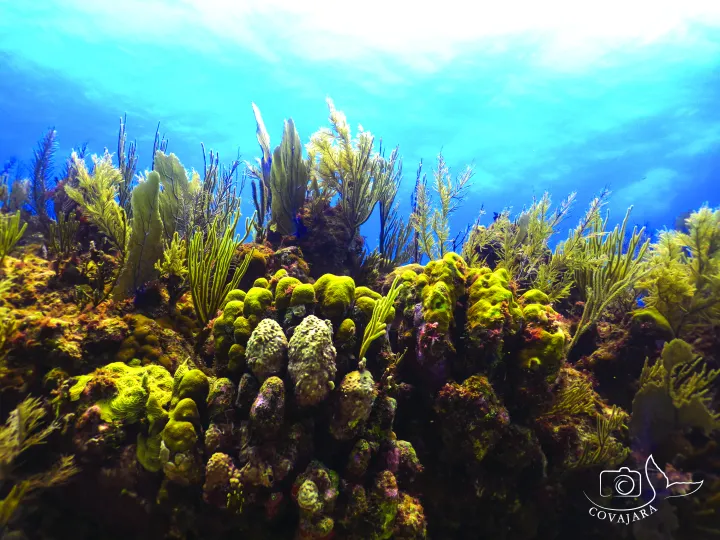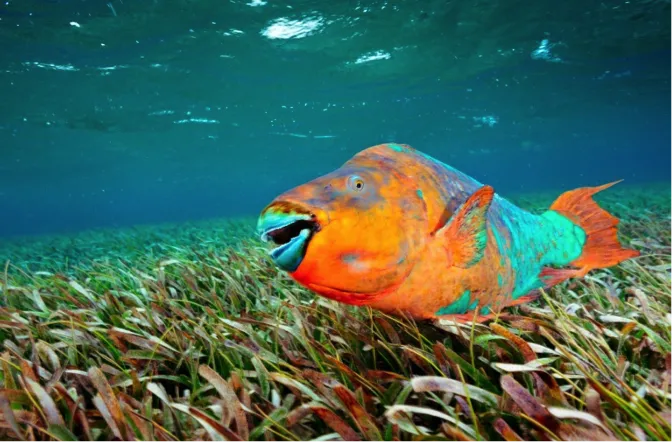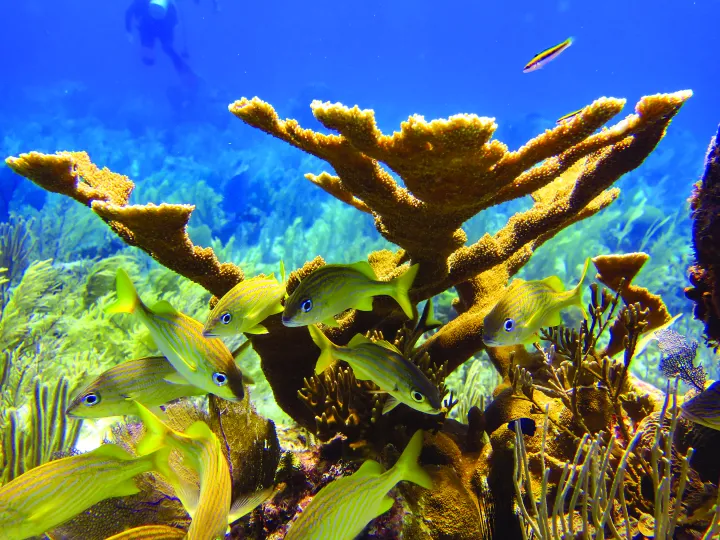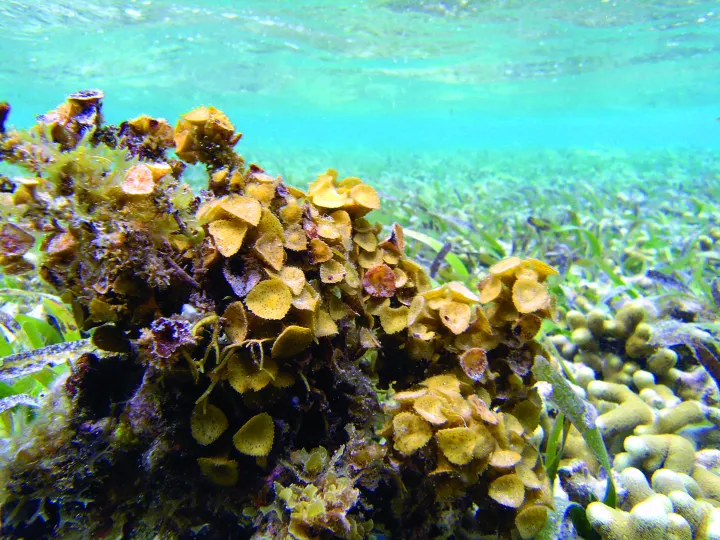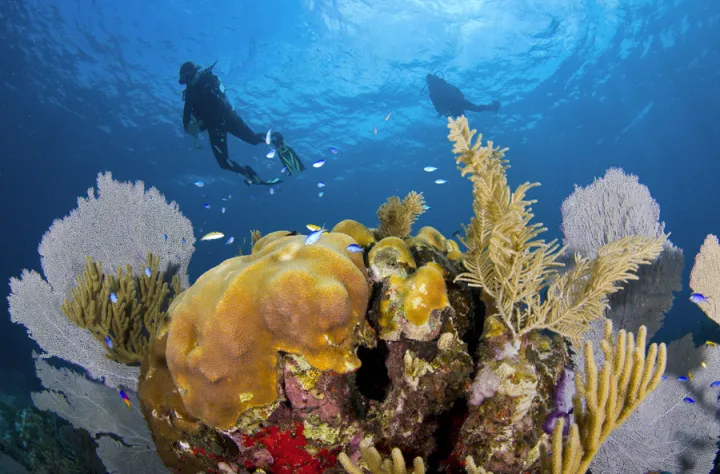Stories of Success from a Reef Report Card
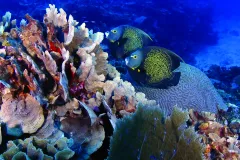
Coral reef ecosystems face daunting threats worldwide. Human impacts, such as overfishing and habitat degradation, alongside the climate change impacts of ocean warming, acidification, and sea level rise are increasingly ravaging reefs. However, as these threats increase, so do conservation efforts.
Report cards help us to keep track of our progress, and in the face of the changing ocean landscape, coral reefs could use report cards to keep track of their progress. That’s why every two years the Healthy Reefs for Healthy People Initiative (HRI), which involves 73 organizations led by the Smithsonian, releases a report card on the health of the Mesoamerican reef. The Mesoamerican reef ecoregion stretches along the coastal waters of Mexico, Belize, Honduras, and Guatemala.
This year, for the first time in the twelve-year history of the large barrier reef’s report card, the overall health of the nearly 300 coral reef sites sampled declined. However, overall reef health still shows improvement compared to its 2006 starting point. And although reef health declined in 2020, there are still other stories of success to share from the progress of the past two years.
While the reef gets an overall grade, each country gets its own individual grade as well. The Belizean reef took home a report card showing improved grades across three categories. To measure reef health, HRI grades the reef in four categories that make up an overall score known as the Reef Health Index (RHI).
The first two categories are percentage of coral cover and macroalgae cover. On a healthy reef, the percentage of coral cover will be high and macroalgae cover will be low. Belize’s 2020 scores improved, with coral cover increasing and macroalgae cover decreasing, although overall grades remained the same (“Fair” and “Good”, respectively). The other two grades are for the total amount of herbivorous fish and commercial fish on a reef, a measurement known as biomass. These are both “subjects” that reefs want high marks in as healthy fish populations are an indicator of overall reef health. While the Belizean reef didn’t see an improvement in the commercial fish category, it did receive improving marks on its herbivorous fish populations—receiving a “Good” grade for the first time, ten years after protecting these key herbivorous fish.
With an increasingly healthy balance of coral to macroalgae cover and robust herbivorous fish populations, Belize has successfully restored both structure and function to its coral reefs, with an overall RHI improvement as a mark of this important progress.
Director of the HRI team, Melanie McField, shared that a large factor of the success seen in Belize was their move to protect parrotfish back in 2009, which was enforced beginning in 2010. Parrotfish are important herbivores who graze on reefs, reducing macroalgae cover which, over time, allows for a rebound of coral cover.
“We have seen an overall increase in herbivorous fish with a decrease in macroalgae a few years later,” McField said. “It’s not immediate, but over a few years you begin to see it.” Belize made the move to protect parrotfish early on, which is why the country is seeing results on their reef today. While Belize had improving grades on their report card, Mexico and Guatemala had an RHI that remained the same. Researchers still hope to see improving grades from Mexico and Guatemala on their next report card, as parrotfish are now protected throughout the Mesoamerican region.
Despite its static report card grade, stories of hope arose from Mexico’s Mesoamerican reef when communities mobilized. After a large mangrove ecosystem in Cancun was bulldozed overnight for commercial development, concerned citizens filed numerous legal complaints. The construction project was eventually stopped as authorities recognized the importance of environmental services provided by the mangroves, and restoration is currently underway.
On a separate occasion, when a large sea turtle nesting area in the Mexican Caribbean was threatened by two development projects, locals exposed the risk to the turtles and the non-feasibility of the projects, leading to their rejection by authorities. These stories of citizens successfully speaking up for local ecosystems shows that ocean conservation success comes not just from efforts underwater, but on land too.
Finally, in the case of Honduras, reef health, unfortunately, decreased. This last country may not have brought home the best report card, but that doesn’t mean there’s no cause for hope. The health of the reef could be improved by increasing the amount of fully protected zones inside marine protected areas and scaling up enforcement efforts for herbivorous fish. With proper protections, Honduras may see macroalgae decrease and coral cover slowly increase, leading to improving grades on a report card down the line.
Smithsonian scientists are studying the roles of three key herbivorous groups on the Mesoamerican reef. In addition to the parrotfishes, the Caribbean king crab and the Diadema (long-spine black) sea urchin have been identified as organisms that help reduce macroalgae cover. Though their ecosystem role was previously overlooked, the Caribbean king crab has been identified as an important grazer that may even reduce macroalgae cover on reefs at a greater rate than parrotfish.
When HRI researchers transplanted adult king crabs onto protected reefs in the region they found a decrease in turf and macroalgae over time and, most notably, an increase in coralline algae—a substrate that promotes coral growth. The HRI team is now working to develop a sustainable, small scale mariculture system that would include placing juvenile king crabs on natural reefs. Researchers anticipate that this will not only promote healthy grazing at these sites, but also support local economies and fisheries.
The HRI team has also been experimenting with ways to enhance natural Diadema sea urchin's population recovery. A new study in Honduras is deploying urchin “condos” in an attempt to provide necessary shelter for these reclusive herbivores in areas overgrown with macroalgae.
HRI director McField says that the continued progress and successes of the initiative are largely due to its collaborative nature and community involvement. “We’re sharing information among the four countries and helping each other help the reef,” McField said. "We cannot prevent some impacts: a major hurricane, a massive coral bleaching event or disease outbreak —but what we have in place is a strong network of 73 partner organizations that will help respond quickly and rebuild.”
As long as reef ecosystems continue to face threats, HRI collaborators and researchers will continue to protect and monitor reefs across the Mesoamerican reef eco-region. That means in two more years, the reef will bring home another report card, where researchers hope to see improving marks as a result of their monitoring and informed conservation efforts.


